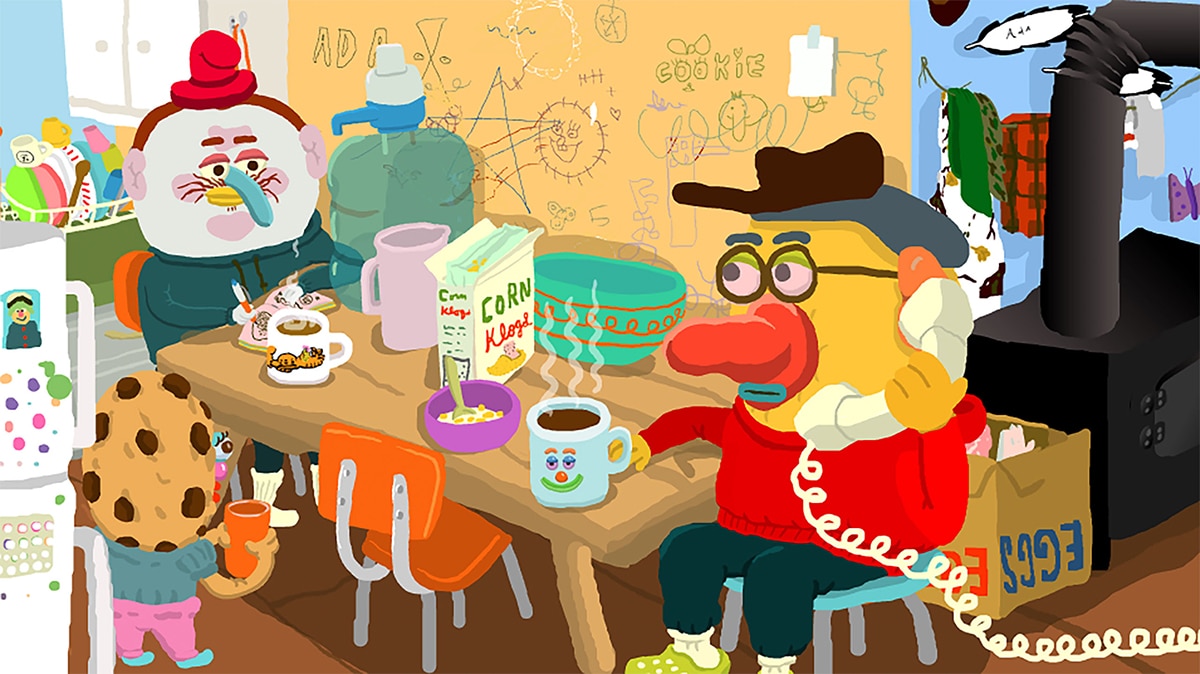Life is rarely neat. It’s full of joyful chatter, stories shared over couches and dinner tables, painful moments, and the love that holds us all together despite it all. Endless Cookie is a Sundance documentary by Canadian filmmakers and half-brothers Pete and Seth Scriver that proves that point. It stands apart from other documentaries in its bold animated style and its commitment to an almost stream-of-consciousness narrative.
The documentary’s animation brings to life Pete and Seth’s conversations, who are Cree and White, respectively, and often catch the chatter and aural atmosphere of family life. The result is a silly but sweet documentary that creates a vibrant, poignant, and often absurd reflection of Indigenous life through its embrace of nonlinear storytelling and poignant honesty.
Endless Cookie is structured like a large family gathering, communing with everyone. Warm, funny, and a little chaotic. A story begins, then goes in a completely different direction, and then back to the start. Pete is the head storyteller here, sharing anecdotes from his childhood, family members, and time spent in Toronto as a young man. Seth records, and you can’t tell where one thread ends and another begins. A story about Pete’s hand getting stuck in an animal trap weaves in and out of various asides. We learn about the Scriver family history, moving back and forth in time (and in one segment, even a little into the future).
The result is a unique blend of urgent and important topics balanced with whimsical animation and a strong sense of humor. Pete tells his stories, like the one where one of his uncles had an owl who would not leave his arm, and through asides, Seth adds context. Like that this uncle was taken to a residential school in Canada as a child and didn’t return until he was 19.
Meanwhile, a segment on the TV called “Canadian Idle” comes in and out, featuring radio reports on the issues faced by Indigenous communities in Canada. We hear reports of water safety, uneven incarceration rates, and more as the silly animation moves forward.
Later, Pete tells a story about how his mom would prepare Caribou stomachs from the body, drying and sugaring it, so it would become a kind of candy. It’s tender, but there’s a punchline here too: “It was the first candy I ever had, and it was awful!” Pete laughs. Endless Cookie is built upon this foundation of real stories, the nostalgic and the horrific, coming together. Much like life, it can be absurd but never boring.
Bright pinks, vibrant reds, and glaring greens are some of the many colors that jump out from every frame of Endless Cookie, a detail that contributes to the film’s reflection of life. Character designs are not rooted in anything recognizably realistic, but instead capture the vibes or essence of who they’re representing. When I saw Pete and Seth get on stage for the post-film Q&A, I could immediately tell who was who based on their animated versions.
Mixed media also helps, recreating the essence of the very real subjects at the center of this film: at several points, we reminisce with the Scriver family and get to see actual photos of the people (and multitude of dogs) we’ve been spending time with. The space between the animated versions of the Scriver family and the photos is full of love – you can the affection for everyone depicted in the drawing. Even the dogs get unique characterizations, right down to one “Peanut” being animated as a dog version of Mr. Peanut.
The visual style of Endless Cookie underscores the personal, community-focused nature of the material. The chaos of the chatter and the communal contributions of the entire family make it a warm, familiar watch. Pete and Seth’s relationship could be any strong sibling bond, but here it’s a bridge that lets the audience into a specific slice of life that’s vital to witness.

